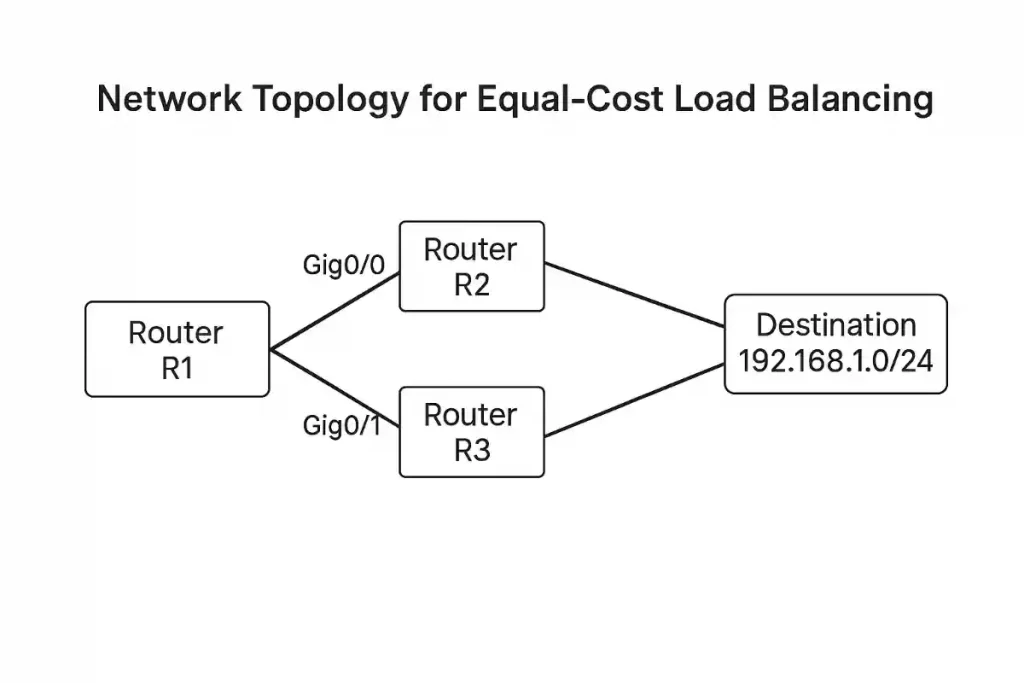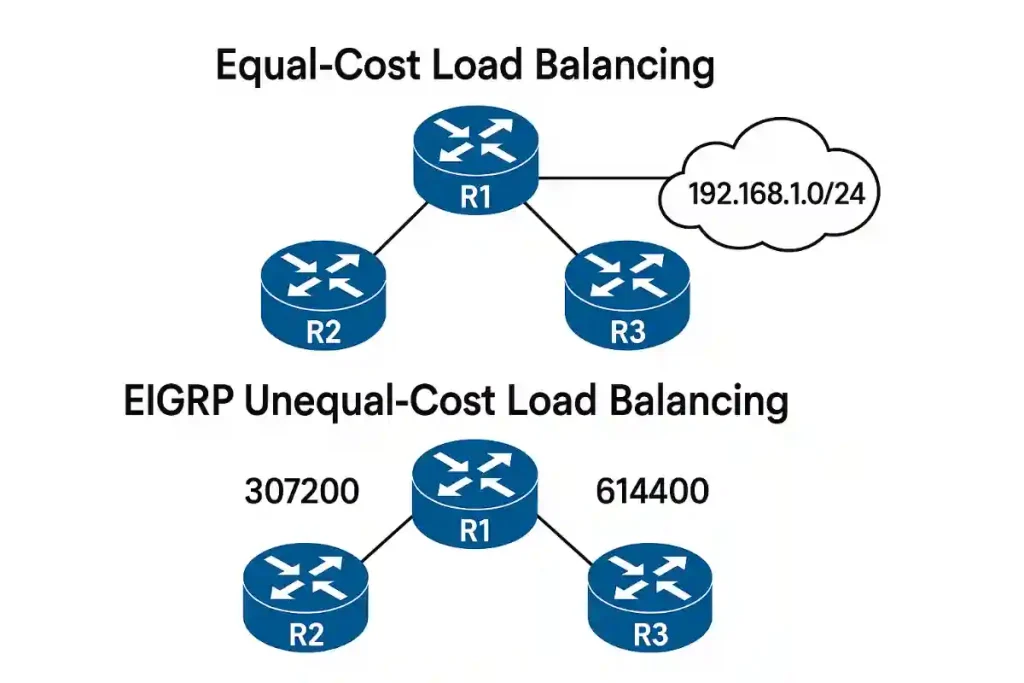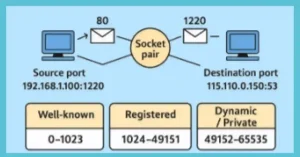Routers use administrative distance (AD) to prioritize routes learned from different routing protocols when multiple paths to a destination exist. AD is a value assigned to each routing protocol, with lower values indicating higher preference (e.g., EIGRP AD is 90, OSPF AD is 110).
If multiple paths exist within the same protocol (same AD), the router uses the protocol-specific metric to select the best path(s). For example, EIGRP uses a composite metric based on bandwidth, delay, reliability, load, and MTU, while OSPF uses cost based on interface bandwidth. If multiple paths have equal metrics, the router installs all such paths in the routing table for equal-cost load balancing.
| Routing Protocol | Administrative Distance |
|---|---|
| Connected | 0 |
| Static | 1 |
| EIGRP (Internal) | 90 |
| OSPF | 110 |
| RIP | 120 |
| EIGRP (External) | 170 |
To perform equal-cost load balancing, a router requires multiple paths to the same destination through a single routing protocol, with each path having the same administrative distance (AD) and metric. Protocols like EIGRP, OSPF, and BGP support equal-cost load balancing. For example:
- EIGRP: Installs up to 4 equal-cost paths by default (configurable up to 32 with maximum-paths).
- OSPF: Installs up to 4 equal-cost paths based on interface cost (configurable up to 32).
- BGP: Supports equal-cost multipath (ECMP) for iBGP or eBGP with maximum-paths.
When multiple equal-cost paths are available, the router installs all of them in the routing table and distributes traffic across them using per-destination or per-packet load balancing. To verify equal-cost paths, use the show ip route command:
Router# show ip route 192.168.1.0
Routing entry for 192.168.1.0/24
Known via "eigrp 100", distance 90, metric 307200
Last update from 10.1.1.2 on GigabitEthernet0/0, 00:00:05 ago
Last update from 10.1.2.2 on GigabitEthernet0/1, 00:00:05 ago
* 10.1.1.2, via GigabitEthernet0/0
* 10.1.2.2, via GigabitEthernet0/1The router calculates multiple routes to a destination with metrics, and the shortest path is installed in the routing table. If the destination has more than one path with the same administrative distance and a metric value, all least-metric and same routes are installed in the routing table.
Network Topology for Equal-Cost Load Balancing
Below is a diagram showing a router (R1) with two equal-cost paths to a destination network (192.168.1.0/24) via two neighbors (R2 and R3).

EIGRP Unequal-Cost Load Balancing
Unlike other routing protocols, EIGRP supports unequal-cost load balancing, allowing paths with different metrics to be used for It. This is configured using the variance command, which specifies a multiplier for the best metric. Paths with metrics up to variance * best metric are included in the routing table, provided they meet the feasibility condition (the advertised distance of the path is less than the feasible distance of the best path).
Configuration Example: Suppose a router has two paths to 192.168.1.0/24:
- Path 1 (via 10.1.1.2): Metric = 307200
- Path 2 (via 10.1.2.2): Metric = 614400
To enable unequal-cost load balancing with a variance of 2 (allowing paths with metrics up to 2 * 307200 = 614400), configure:
Router(config)# router eigrp 100
Router(config-router)# variance 2
Router(config-router)# maximum-paths 4Verification
Router# show ip route 192.168.1.0
Routing entry for 192.168.1.0/24
Known via "eigrp 100", distance 90, metric 307200
Last update from 10.1.1.2 on GigabitEthernet0/0, 00:00:05 ago
Last update from 10.1.2.2 on GigabitEthernet0/1, 00:00:05 ago
* 10.1.1.2, via GigabitEthernet0/0 (307200/281600)
* 10.1.2.2, via GigabitEthernet0/1 (614400/588800)We can configure EIGRP to install multiple paths even if the metric is unequal. This is the only protocol that supports unequal cost load balancing. The Cisco router uses two types for balancing the network load: per-destination basis and per-packet basis. Balancing the load also depends on the switching mechanism configured on the router interface.
Switching Mechanisms and Load Balancing
The efficiency of load balancing depends on the router’s switching mechanism, which determines how packets are forwarded. Cisco routers support two main methods:
- Process Switching: The CPU processes each packet individually, consulting the routing table. This is slow and not suitable for high-speed load balancing, as it increases CPU load and latency.
- Cisco Express Forwarding (CEF): CEF pre-builds a Forwarding Information Base (FIB) and adjacency table, enabling fast, hardware-based forwarding. CEF is the default on most modern Cisco routers and is essential for efficient per-destination and per-packet load balancing.
CEF and Load Balancing:
- Per-Destination Load Balancing: CEF uses a hash of the source and destination IP addresses to select an outgoing interface, ensuring all packets for a given flow use the same path (default behavior).
- Per-Packet Load Balancing: CEF alternates packets across available paths, ensuring equal utilization but potentially causing out-of-order packets. Enable with:
Router(config-if)# ip load-sharing per-packet
Verification
Router# show cef interface GigabitEthernet0/0
GigabitEthernet0/0 is up (if_number 2)
IP CEF switching enabled
IP CEF load sharing: per-destinationPer-destination load balancing
In this type, the router distributes the packets based on the destination address, distributes all packets for a specific destination over the first path, and uses the second path for the second destination on that same network. For most Cisco routers, per-destination load balancing is the default technique.
Per-Packet load balancing
In this type, the router sends one packet for the same destination over the first path, and the second packet for the same destination over the second path, and so on. Per-Packet guarantees equal load across all links.
Troubleshooting Load Balancing
Load balancing issues can arise due to misconfigurations or network conditions. Below are common problems and solutions:
Unequal-Cost Paths Not Used in EIGRP:
- Problem: Only the best path is used despite configuring variance.
- Solution: Ensure the alternate path meets the feasibility condition (advertised distance < feasible distance of the best path). Verify with
show ip eigrp topology.
Command
Router# show ip eigrp topology 192.168.1.0
Load Balancing Not Occurring:
- Problem: Traffic uses only one path despite multiple equal-cost paths in the routing table.
- Solution: Check if CEF is enabled (
show cef interface) and ensure load sharing is set to per-destination or per-packet.
Command
Router(config-if)# ip load-sharing per-packet
Out-of-Order Packets with Per-Packet Load Balancing:
- Problem: Applications experience issues due to packets arriving out of order.
- Solution: Switch to per-destination load balancing, as per-packet can disrupt sensitive applications like VoIP.
Command
Router(config-if)# no ip load-sharing per-packet




